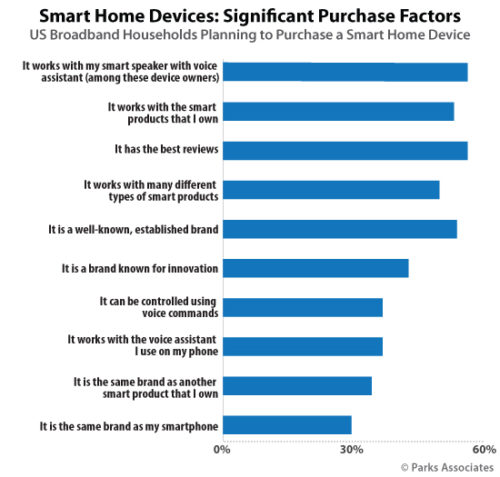U.S. broadband households own more than 10 connected devices
Wednesday, March 27th, 2019
Consumers own more than 10 connected devices
- Industry report addresses convergence of technology and the smart home
A new Parks Associates report finds that smart home solutions will increasingly rely on voice control, video and data analytics, sound recognition, and AI to simplify the user experience. Technology Convergence and the Smart Home reports US broadband households now own more than 10 connected devices, including a mix of connected CE, smart home, and connected health devices, and as they buy more, they base their purchase decisions on a product’s ability to work with the existing devices in their home.

“Interoperability continues to be a leading challenge for the smart home industry,” said Chris O’Dell, Research Associate, Parks Associates. “Nearly 75% of consumers who intend to purchase a smart home device in the next year report that the ability for that device to work well with other devices is an important factor in their purchase decision. This challenge intensifies when consumers purchase stand-alone devices at different times, from different brands, rather than purchasing smart home systems.”
The report also finds more than 30% of computing and entertainment device owners report experiencing loss of wireless connectivity, with home network routers as the most common source of the problems. New solutions based on mesh networks and 5G technologies are aimed to resolve wireless issues.
“Mesh networks are designed to better manage Wi-Fi connectivity in the home and will help improve the user experience as consumers add more wireless devices to the home,” O’Dell said. “The amount of wireless data is increasing substantially, and the rollout of 5G technologies will ease the burden on both mobile and home networks.”
Technology Convergence and the Smart Home reviews the evolution of technology across multiple dimensions, such as AI, robotics, and distributed computing, and the impact on hardware cost and software development lifecycle. It also provides a vision of the future state of the smart home and outlines strategies needed to compete successfully in the long term.
Additional research includes:
- Consumer interest in products supported with advanced analytics is strong—67% of consumers rate “alerts when someone enters your home,” a key video analytics capability, as the most appealing among a range of home security features.
- 75% of US broadband households want to keep tight control over their personal data, and 45% are “very concerned” about hackers gaining control of their connected devices.
- Smart home purchase intentions have increased from 21% at the beginning of 2014 to 43% at the end of 2018, with 31% of consumers reporting high intention to purchase one of these devices.
Latest News
- Spideo and OTTera unveil personalisation collaboration at NAB Show 2024
- Amagi integrates Intertrust DRM for FAST services
- Vantiva has shipped 22 million Android TV set-top boxes
- Newsmax launches subscription-based app with 24i
- Slovak Telekom and T-Mobile CZ upgrade video streaming with 24i
- CTV/OTT expected to be fastest growing media channel in U.S. in 2024